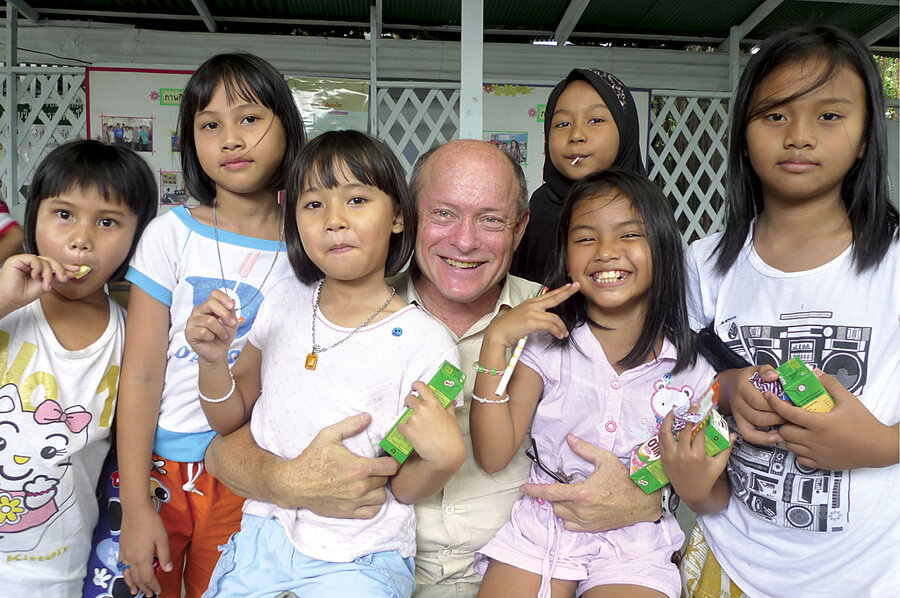From our Lao friend Somdy told us about this sick monk we were able to raise $500 for his surgery. Here are photo,, before and after photos here:
BANGKOK, THAILAND
Marc Gold spends most of his time on the road. One month he may be in India or Afghanistan; the next he's in Cambodia or Vietnam, both of which he's visited numerous times.
But he doesn't travel to see the sights. The retired community-college professor from San Francisco pursues his own brand of tourism: philanthropic travel.
"I go where the poor people are," Mr. Gold says.
He slogs muddy dirt tracks to far-flung Tibetan villages, scouts garbage heaps teeming with destitute scavengers in Indonesia, and legs it around slums in India.
Everywhere he goes, Gold performs acts of kindness, both random and preplanned. He hands out soccer balls and art supplies to children at a Tibetan orphanage. He helps an elderly scavenger in Sulawesi, Indonesia, open a small grocery store. He buys a year's supply of rice for battered women at a shelter in Jaipur, India.
He rarely spends more than a few hundred dollars. "For people who live on a dollar or less a day, $50 can make a big difference," says Gold, who has been dubbed "the shoestring philanthropist."
As little as $10, he adds, can get a poor child into school. "Imagine saving a woman's life for a dollar, the price of a candy bar [in the US]," he says.
He may have done that in 1989. While visiting Darjeeling in the Indian Himalayas as a tourist, he befriended a young Tibetan refugee and his wife, who kept nursing her ears. Gold, who trained as a psychiatrist, thought she could have a serious ear infection. He found her a doctor and paid for antibiotics, which cost $1. Another $30 got her a hearing aid. She squealed with delight at being able to hear again.
That led to an epiphany. "I'd thought you had to be rich to do such things," he recalls. "I realized I had the power to help change people's lives."
Back home, he asked a hundred friends for small donations and was soon back in India with $2,200. He then set up a nonprofit charity and called it 100 Friends.
Two decades later, 100 Friends has some 4,000 members worldwide, and last year Gold raised $200,000. He continues fundraising via his portable office: a laptop, a digital camera, and a cellphone.
"This is 80 percent of what I own," Gold says during a stopover in Bangkok, pointing at two duffel bags stuffed with his clothes, dog-eared paperbacks, and his large collection of wacky rubber masks.The latter he uses for clowning around with children from Tibet to Thailand. "I don't need much, and I'm free."
A divorcee with two adult sons, Gold took early retirement in 2003 and began devoting himself full time to his mission.
"He focuses on the bang for the buck," says Shon Pistoll, a musician from Philadelphia who accompanied the itinerant philanthropist on his recent six-week trip to India, Gold's 13th visit there. "A donation goes straight from his hand to the hands of people who need it most."
Gold once put a 50 cent piece to good use. It was from a fifth-grader in Los Angeles, who gave Gold his lunch money. He took the coin to Kabul, Afghanistan, where he spent it on a pair of flip-flips for a street child he saw walking around barefoot. The most he's ever spent was also in Afghanistan: $20,000 to build a school in the war-torn country.
He's also built schools in Ethiopia, Cambodia, and Burma (Myanmar). He's helped stock libraries in Vietnam, India, Tibet, and Indonesia. He bought warm blankets for orphans in Malawi in Africa and paid for 500 wheelchairs for disabled people in Vietnam. In Cambodia, he sent a young land-mine victim to vocational training so he wouldn't end up as a beggar. In Nepal, he sponsors 150 young girls, at the price of one goat each, to keep them from being hired out into bonded slavery by their parents.
"Marc has saved me and my family," says Lhamo, a young Tibetan woman who first met Gold near her hometown in China's vast hinterland. "If not for him, I would have spent my whole life [in poverty] on a farm."
Instead, Lhamo has completed a two-year college program in China. Next September she will continue her studies on a scholarship in California. Her younger brother is in school, too. "Marc encourages me to study hard. He's been like a father to me," Lhamo says.
"I want to enable people to support themselves," Gold says.
His help comes with a string attached.
"I have this principle that people have to pay me back – by helping others, by paying it forward," he says.
A man in Calcutta, whose broken-down rickshaw Gold repaired, now takes nuns from Mother Teresa's local mission on their charity rounds free of charge. A fisherman in Banda Aceh, Indonesia, whose boat Gold restored after the devastating Indian Ocean tsunami in December 2004, gives away some of his catch to poor families.
"Marc told me not to try and save the world," says Dwight Turner, a teacher from Atlanta who was inspired by Gold's work and now runs his own volunteer project for children in Bangkok slums. "He said, 'Help the people you can.' "
• Find 100 Friends at www.100friends.org
• For more stories about people making a difference, go here.














